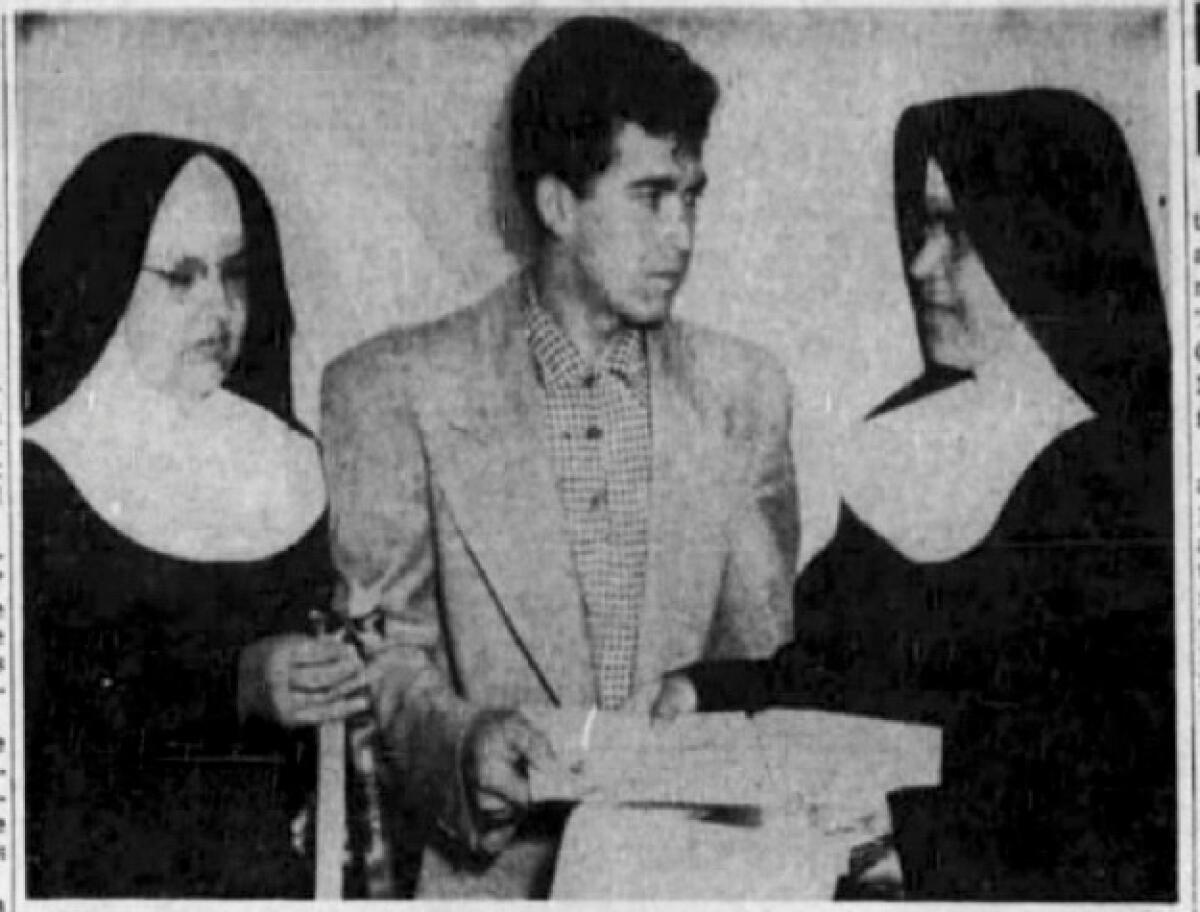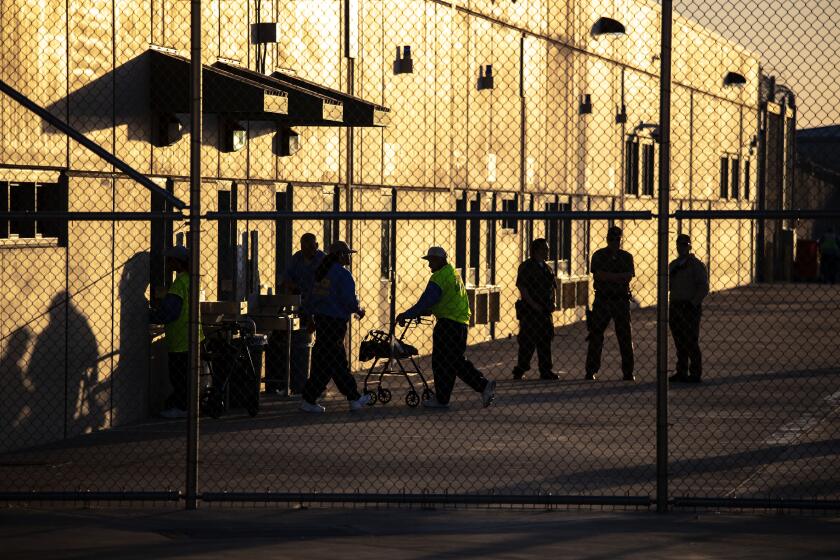When the deportation of an illegal immigrant united L.A. to bring him back

- Share via
When I think about the gleeful cruelty the Trump administration is showing toward illegal immigrants — including unlawfully deporting planeloads of them, seeking to suspend habeas corpus in order to kick out folks faster and wearing fancy Rolex watches while visiting a Salvadoran super prison — I think of Jose Toscano.
The Mexico City native came to Los Angeles as a 13-year-old and enrolled at St. Turibius School near the Fashion District, working at Magee’s Kitchen in the Farmers Market to pay his tuition, room and board. “I had this dream to come to the United States for education,” Toscano told The Times in May 1953. “Not for the dollars, not to work in the camps for 65 cents an hour.”
You're reading the Essential California newsletter
The most important California stories and recommendations in your inbox every morning.
You may occasionally receive promotional content from the Los Angeles Times.
Why was The Times profiling a 16-year-old Mexican immigrant? Because he was about to get deported. Politicians, the press and private citizens had been railing against “illegal immigration” and pushing President Eisenhower for mass deportations. Officers received a tip that Toscano was in the country illegally.
This young migrant’s story struck a chord in Southern California in a way that’s unimaginable today
Newspaper accounts noted that immigration authorities — struck by Toscano’s pluck and drive — made sure that his deportation didn’t go on his record so he could legally return one day. A Van Nuys News and Valley Green Sheet columnist wrote, “We must have immigration laws — but they’re not designed for folks like Joe.”
Meanwhile, The Times’ editorial board — not exactly known back then for its kind attitude toward Mexican Americans — argued that Toscano shouldn’t be deported, making the case that laws “should perhaps be tempered a trifle in the face of principles and actions which are of such sterling worth as to be beyond the object of the law itself.”
Toscano legally returned to Los Angeles three months later, living with a white family in Whittier that sponsored him and enrolling at Cathedral High. “As I continue to study the history of your country in school,” he wrote to The Times that September, “I shall remember that what you did for me is one of the things that makes this country of yours so great.”
His story was such a feel-good tale that it appeared in Reader’s Digest and the local press checked in on Toscano for years. The Mirror, The Times’ afternoon sister paper, reported on his 1954 wedding, the same year that immigration officials deported over a million Mexican nationals under Operation Wetback, a program that President Trump and his supporters say they want to emulate today.
Two years later, The Times covered Toscano’s graduation from Fairfax High, where he told the crowd as the commencement speaker that he wanted to become an American citizen “so that I, too, can help build a greater America.”
After a three-year stint in the Marines, Toscano did just that in 1959, changing his legal name from Jose to Joseph because he felt “it’s more American that way,” he told the Mirror. He told the paper he had dreams of attending UCLA Law School, but life didn’t work out that way.
Lessons for today
The last clipping I found of Toscano in The Times is a 1980 Farmers Market ad, which noted that he was a widower with two daughters still working at Magee’s but had advanced from washing dishes to chief carver.
“He’s a happy man who likes his work,” the ad said, “and it shows.”
Rereading the clips about Toscano, I’m reminded of Kilmar Abrego Garcia, the Salvadoran national who established a life for himself in this country before he was deported in March despite a judge’s order that he be allowed to remain in the United States.
This time around, immigration officials and the Trump White House have insisted Abrego Garcia deserved his fate, sliming him as a terrorist and MS-13 member despite no evidence to back up their assertions.
Toscano’s story shows that the story can have a different ending — if only immigration officials have a heart.
Today’s top stories

‘Low income’ but making $100,000 per year
- In Orange, Santa Barbara and San Diego counties, the threshold for a low-income single-person household will soon surpass $100,000 if current trends continue.
- Between 2020 and 2025, the threshold to be considered low income rose 40% across Southern California’s 10 counties, reflecting the rising cost of living across the region.
- Recent polling shows Californians are stressed about their finances.
Newsom walks back free healthcare for eligible undocumented immigrants
- The governor’s office said his spending plan, which will be released later this morning, calls for requiring all undocumented adults to pay $100 monthly premiums to receive Medi-Cal coverage and for blocking all new adult applications to the program as of Jan. 1.
- The cost of coverage for immigrants has exceeded state estimates by billions of dollars.
California joins another lawsuit against Trump
- California Atty. Gen. Rob Bonta filed two lawsuits Tuesday challenging a Trump administration policy that would deny the state billions of dollars in transportation grants unless it follows the administration’s lead on immigration enforcement.
- California sued Trump 15 times in his first 100 days in office. Here’s where those cases stand.
California’s ethnic studies mandate is at risk
- California became a national pioneer four years ago by passing a law to make ethnic studies a high school graduation requirement.
- But only months before the policy is to take effect, Gov. Gavin Newsom is withholding state funding — delaying the mandate as the course comes under renewed fire.
What else is going on
- Seventeen members of a cartel kingpin’s family were escorted into California from Mexico. Why?
- A DoorDash driver helped cheat the company out of $2.5 million using phantom deliveries.
- An L.A. judge resentences the Menendez brothers, giving them chance at freedom.
- Sean ‘Diddy’ Combs’ ex-girlfriend Cassie testifies at his trial about abuse and ‘freak offs.’
- A judge backs State Farm’s 17% emergency rate hike for homeowners.
- Pete Rose and ‘Shoeless’ Joe Jackson were reinstated by Major League Baseball, making Hall of Fame election possible.
Commentary and opinions
- Four months into insurance claim delays and disputes, a new blow to fire victims: A rate hike, writes columnist Steve Lopez.
- My neighborhood, Skid Row, is not exactly what you think it is, argues guest columnist Amelia Rayno.
- The Endangered Species Act is facing its own existential threat, contributor Marcy Houle says.
This morning’s must reads
Dani Dazey made a name for herself designing the Trixie Motel in Palm Springs. Now she’s created her dream home in L.A., every inch covered in wallpaper, color and patterned textiles.
Other must reads
- Jamie Lee Curtis just wanted an AI ad removed, not to become the ‘poster child of internet fakery.’
- Researchers find drinking water is safe in Eaton and Palisades burn areas as utilities lift last ‘do not drink’ order.
- Under her eye: The blessings of Ann Dowd as Aunt Lydia in ‘The Handmaid’s Tale.’
- Big Bear eaglets get ready to fly: See how they’ve grown.
For your downtime
Going out
- Hiking: Get away from it all with a serene backpacking trip near L.A. — it’s easier than you think.
- Theater: ‘White Rabbit Red Rabbit,’ with a new star every night, opens at the Fountain Theatre in East Hollywood.
- Theme parks: Disneyland reopens ‘It’s a Small World’ ride with new additions from ‘Coco.’
- Cup o’ joe: 11 coffee shops along the Santa Barbara coast for your next weekend road trip.
Staying in
- Television: For the first time, sports fans will be able to subscribe to ESPN without signing up for satellite or cable TV. It will cost $29.99 a month.
- Books: A new book unearths never-before-seen maps of Disneyland from the early 1950s.
- Recipes: Here’s a recipe for niçoise salad baked potatoes.
- ✏️ Get our free daily crossword puzzle, sudoku, word search and arcade games.
A question for you: What is your go-to karaoke song?
Stephen says: “Anything by Jim Croce.”
Alan says: “‘In My Life’ by The Beatles.”
Email us at essentialcalifornia@latimes.com, and your response might appear in the newsletter this week.
And finally ... your photo of the day

Today’s great photo is from Times photographer Juliana Yamada at the Kia Forum where fans flocked to see legendary singers Chaka Khan, Patti LaBelle, Stephanie Mills and Gladys Knight perform their greatest hits.
Have a great day, from the Essential California team
Gustavo Arellano, California columnist
Kevinisha Walker, multiplatform editor
Karim Doumar, head of newsletters
How can we make this newsletter more useful? Send comments to essentialcalifornia@latimes.com.
Sign up for Essential California
The most important California stories and recommendations in your inbox every morning.
You may occasionally receive promotional content from the Los Angeles Times.









